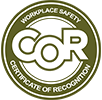How Proper Particle Filtration Reduces Risks in Confined Space

Old style confined space ventilation systems blow polluted air out of the space, often without much thought about where it will go. When the work in the confined space involves welding, gouging or grinding metals that contain chromium, nickel, manganese or another toxic metal, that polluted air becomes a hazard to everyone in the area. Removing paint that contains lead or other toxic metals presents similar hazards.
Effective particle filtration is by far the most effective way to eliminate the risk of harmful effects from toxic particles. Because many of those particles are less than 5 microns in diameter, too small to see with the naked eye, the particle filtration system must be efficient at removing particles 1 micron and smaller. The large quantities of particles generated by welding, gouging, abrasive blasting and other processes demand particle filtration systems that can handle orders of magnitude more dust than air conditioning filters.
Industrial Particle Filtration Systems
Industrial particle filtration systems have traditionally been rated according to the % by weight of particles larger than a certain size, e.g. 99.9% of particles larger than 0.5 microns. In recent decades workplace exposure limits have dropped into the micrograms per cubic meter range. Concerns have arisen that the small portion of dust that makes its way through the 99.99% filters may be hazardous. Where air heating or cooling costs make it desirable to return filtered air to the workplace, secondary filters are used. For several decades, these were known as HEPA filters, rated 99.97% efficient on 0.3 micron diameter particles.
There has been a shift in recent years to testing industrial dust collectors according the MERV standard that was developed for commercial air conditioning filters. Where it is necessary to clean highly polluted air to a high standard the traditional 2 stage approach is still used. These particle filtration systems use a cartridge filter bank equipped with an automatic cleaning system to remove at least 99.9% of the dust (by weight) and a HEPA or MERV 15 to 17 filter to trap the remaining particles. If the MERV 17 filter alone is used, it may be plugged in a matter of hours, and will certainly require frequent replacement. Installing the cartridge filter ahead of it reduces the cost per kilogram of dust collected dramatically.
MERV Ratings
Users and manufacturers of industrial particle filtration systems recognize that MERV ratings give very little information about the cost effectiveness of a dust collection system. In response to that they have developed ANSI/ASHRAE Standard 199-2016. Tests set out in that standard simulate the normal cycle of operation of an industrial particle filtration system. The results reported will include the particulate emissions from the collector, in mg/m^3, the differential pressure average in inches water gauge, and the volume of compressed air used for filter cleaning, in relation to the volume of air flowing through the collector. These results will help purchasers and renters of dust collectors make more informed choices.
The Benefits of Dust Collectors
When particle filtration is applied to confined space ventilation, the dust collectors are more likely to be rented than purchased. The owner of the confined space may be called on to provide power for the fan and compressed air for cleaning, the owner of the collectors will cover other costs. The supplier of the collector may provide a compressor to work with it. Energy costs will be small compared to the other costs of providing and operating the system.







